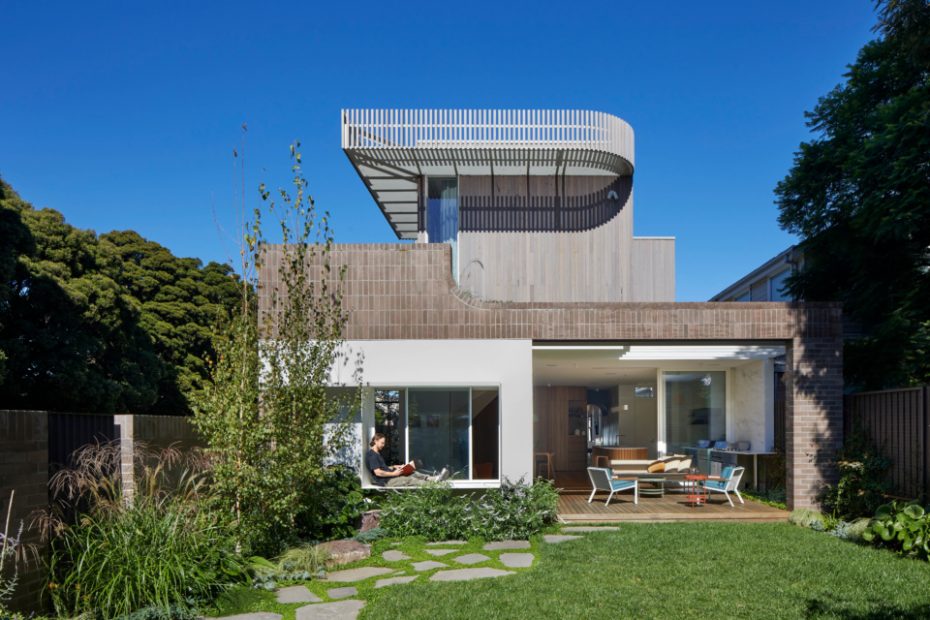A Curvaceous Cottage Extension That Hugs Its Park Neighbour
Architecture
Fringe Dweller’s sculpted extension transforms an unassuming weatherboard cottage into a proud forever home.
Landscape architecture by Peachy Green.
Window framing doubles as a bench seat in the garden.
The seamless overlap between the generous kitchen, indoor dining, and outdoor living area makes for an ideal environment for family-based mealtimes, as well as entertaining.
The generous kitchen takes its rightful place asthe heart of the home and easily overlaps with the adjacent dining table.
The hallway in the original portion of the home.
Everything has its place in the integrated storage.
A sculpture staircase arcs through the area between the living and dining room.
The lounge room looking out to the garden.
Light streams in from north-facing windows.
A screenless lounge promotes family time with minimal digital interruption.
The house helps the clients enjoy the unique civic conditions of their site without compromising a sense of safety and privacy.
Fully tiled walls and floors in the bathroom.
Floor-to-ceiling windows in the main bedroom put the owners face-to-face with the foliage of magnificent mature trees.
The lounge’s attached balcony overlooks the park’s open field.
The treetop balcony view.
The side of the home embraces its position with a strong street presence that appears to ‘hug’ Quarries Park across the street.
Where old meets new.
High fences provide privacy to the garden.
The original heritage facade with curved fretwork.
When designing a house on a prominent street corner, there’s the option to embrace the public visibility of the site, or turn your back to the street.
This alterations and additions project by Mihaly Slocombe balances these two options, creating a home that embraces its park side location and the privacy of the family owners.
Prior to the recent renovation, the Clifton Hill house was a single-storey Victorian cottage. The condition of the original heritage fabric was poor due to significant subsidence, resulting in sinking footings, uneven floors, and wall cracking throughout.
Mihaly Slocombe essentially designed a new home within the same external walls and roof framing, while retaining period features where possible.
Internally, the layout of the original dwelling has been largely preserved, with only a tweak to the proportions.
Erica Slocombe, principal at Mihaly Slocombe explains, ‘One oversized bedroom was reduced in size to accommodate a family bathroom, ensuring the original dwelling neatly contained the kid’s amenities and there would be future democracy between the kids when it comes to bedroom size!’
The extension replaces the existing communal areas in the former lean-to plus a second storey to provide further amenities.
The side of the home embraces its position with a strong street presence that appears to ‘hug’ Quarries Park across the street.
Curves integrated in reference to the existing facade fretwork actually originated from a problem-solving approach to navigate restrictions upon the site’s back corner.
‘The council stipulated that a square corner would infringe on the adjacent laneway,’ explains Erica. ‘We adapted it to a curved edge, and carried this form through the rest of the project.’
Across the interiors, warm blackbutt timber floors, a neutral palette with pops of surprise colour, and the curved edges of furniture and joinery create a feeling of softness that allows gentle transitions between the different zones for cooking, eating and relaxing.
A sculpture staircase arcs through the area between the living and dining room leading up to the parent’s retreat, balcony, and a treetop lounge. Elevated above street level, these spaces more freely relate to the park, evoking a comforting sense of prospect and refuge.
Floor-to-ceiling windows in the main bedroom put the owners face-to-face with the foliage of magnificent mature trees.
The design of Fringe Dweller embraces multiple competing ideas. On a public-facing site, the design of the house allows the clients to be a part of the neighbourhood, without feeling like they live in a fishbowl.
A sense of connection lies at the heart of the design: to family, to the garden, and to the park.
